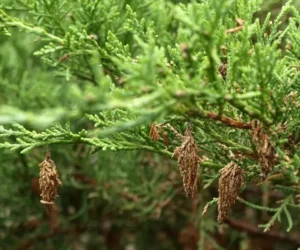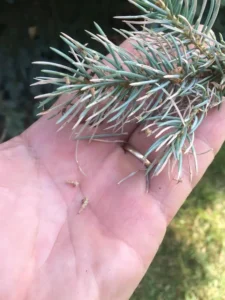
Manage bagworms now so they don’t harm trees
Thanks to the University of Maryland/Maryland Grows this informative article about how to manage bagworms.
Bagworms
“Why are the pinecones on my tree moving?” a client asks.
“Because those aren’t pinecones, they’re bagworms,” I reply.
Dangling from evergreens like teardrop-shaped Christmas tree ornaments, bagworms cause many a homeowner to scratch their head in wonder. Pinecones that dance?

Image Credit: Erik Rebek, Bugwood
But the tell-tale thinning of trees that can follow is no laughing matter. Covered with bits of needles and leaves, the bags that give bagworms their name serve as protection for the caterpillars inside. Bagworm caterpillars are the juvenile form of a moth.
That sounds innocent enough, but like all caterpillar-like insects, they are born hungry. Walking stomachs, they prowl among your trees, munching away to cause sometimes serious defoliation. They particularly enjoy evergreens such as arborvitae, cedars, junipers, and pines. But they will also dine on maples, locusts, lindens, and other deciduous trees.
Bagworm eggs
Eggs hatch out from bagworms’ bags in May. Tiny larvae spin an eighth-inch bag with bits of needles or leaves glued together with webbing. Like tiny backpackers, bagworms tote those bags around as they feed. As they grow, the bags get bigger and bigger and your tree foliage gets thinner and thinner.
I don’t know if bagworms have an adventuresome streak, but they do a bit of hang-gliding. They spin a fine web and use the wind to glide to other trees in a stunt called “ballooning.”
By August or September, the bags – and bagworms – are 1- to 2-inches long. They stop wandering and feeding and tie up to a twig using tough silky threads. In late summer, they transform into moths. But get this, ladies, only the males have wings. So the gals just hang out in their bags and wait for the boys to, um, visit. Post rendezvous, each female bagworm lays 200 to 1,000 eggs in its bag. Next spring, the eggs hatch to start the cycle over again.
Stop the cycle
Stopping that cycle is important and now is a crucial time. Mid-June to mid-July is the best time to treat trees with bagworms with a very effective organic control called Bt. A naturally occurring soil bacteria, Bt or Bacillus thuringiensis kills only small caterpillars. And guess what? Bagworms are just the right size right now. Bt doesn’t harm humans or animals and is easy to find. It’s sold in hardware stores and garden centers under names like Dipel and Thuricide. Applying Bt is a do-it-yourself job if you can reach your trees with a sprayer. If not, call in a pro.
Even easier is picking off the bags if you have only a few bagworms. Snip them off with scissors or pruners, bag and trash them. Don’t leave them on the ground where the eggs can hatch. Since there can be as many as 1,000 eggs in each bag, removal is important. Get those bags gone. And gone before the eggs hatch in May.

Image Credit: Dave Lantz
Learn more about bagworms and see some great photos on the HGIC website.
You can beat bagworms and keep your trees safe. Fortunately, this is one insect for which there is an easy – and organic – fix. So get out there and bag some bagworms.
By Annette Cormany, Principal Agent Associate and Master Gardener Coordinator, Washington County, University of Maryland Extension. This article was previously published by Herald-Mail Media. Read more by Annette.
This article was previously published by Herald-Mail Media.
If you are looking to buy or sell your home (with or without a garden), contact Gigi today. Oh by the way, I’m never too busy for any of your referrals!





Recent Comments